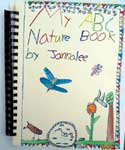ABC Nature Books
Marge Wright
Westside School
Grades One and Two
 |
Marge Wright
Westside School
Grades One and Two
 |
Goal: Students integrate what they have been learning in language arts, science, history/social studies, and art to produce a 28-page book.
Materials:
- white copy paper
- manila tagboard
- plastic comb binding machine
- extra fine tip Sharpie waterproof markers
- colored pencils
- pastels
- watercolors
- crayons
- brushes
- white glue
Procedure:An adult uses the binding machine to make each book with 28 pages of 8.5"x11" copy paper. The covers are put on later.
Students write each letter of the alphabet in the upper right hand corner, skipping the first and last page. They will be filled in as the title page and author's biography page later.
More white copy paper is cut to 6"x6".
Each page contains one letter of the alphabet with a 6"x6" picture glued to the top and the student's writing glued to the bottom. For example, after studying the local oak trees and oak woodlands, collecting, sorting, and planting acorns, the students write a first draft for "A" "Acorn" using the word bank developed during the study.
The teacher meets with each student to edit the first draft, and the student writes the final copy. More advanced writers will end up with more paragraphs than a beginning writer, and use the back of the paper.
Each student uses mixed media to illustrate the ideas in his/her writing. I give direct instruction in how to outline the picture using a waterproof Sharpie marker and fill in with pastels, colored pencils, and/or crayons. Students then paint an overwash with watercolors.
For first and second graders completing one or two pages a week seems to be an appropriate pace to maintain enthusiasm and quality.
At the beginning of the book an adult glues the papers, but most second graders can glue them after seeing the process. Chopsticks can be laid across a page to help it dry without sticking to the previous page.
When the 26 letters are complete, the students use manila tagboard to make the front and back covers. Construction paper could be used but it must be laminated. An adult adds the covers to each book.
Students write a title page and copyright page. The last page is used for a photo of the author and an autobiography.
Please click on image to see larger More examples
Back
© Deborah Padrick 2001